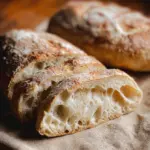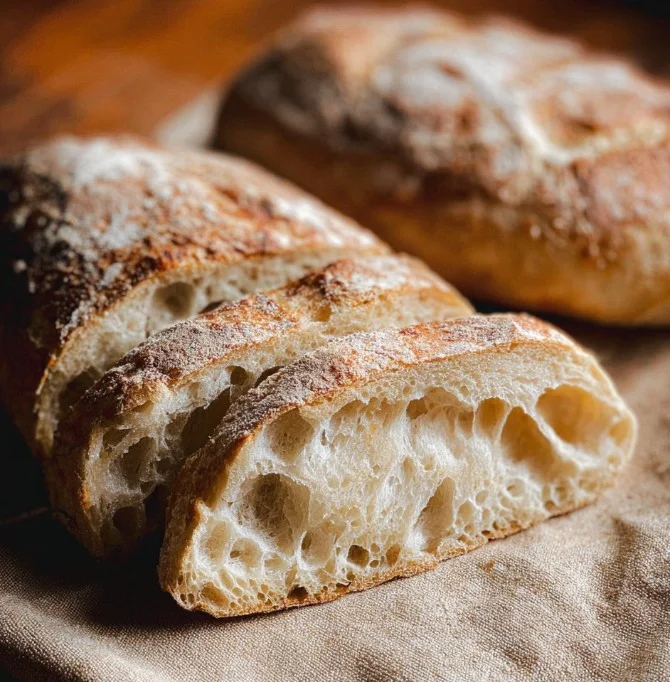Ciabatta bread, a staple of Italian cuisine, has taken the world by storm with its rustic charm and delightful texture. Imagine slicing into a crusty exterior to reveal an airy, chewy interior. This bread isn’t just adored for its taste; it’s also versatile enough to complement various dishes and is perfect for sandwiches. Whether you’re new to baking or have some experience under your belt, making ciabatta bread at home can be an incredibly rewarding process. In this article, we will delve into the ins and outs of crafting the perfect ciabatta loaf, from ingredients to serving suggestions.
Why We Love This Ciabatta Bread Recipe
This ciabatta bread recipe holds a special place in many cooks’ hearts for various reasons. First and foremost, it’s straightforward. Even if you haven’t spent much time in the kitchen, you can tackle this recipe with ease. The ingredients are simple and readily available, making this a practical recipe for anyone.
What truly sets this ciabatta apart is its texture. The method of using a sponge allows for the development of complex flavors and a wonderfully airy structure that’s desirable in artisan bread. Additionally, this recipe offers a level of customization, allowing you to experiment with additions like herbs or olives if you wish.
Making ciabatta at home not only fills your kitchen with the delightful aroma of freshly baked bread but also gives you a sense of accomplishment. Each loaf you produce is a testament to your efforts, making it a satisfying project whether for yourself or to impress friends and family.
Ingredients About Ciabatta Bread
To make an exceptional ciabatta bread, gather the following ingredients:
- For the Sponge:
- 1 cup (130 g) all-purpose flour
- 1/8 teaspoon instant yeast
- 1/2 cup (120 ml) water at room temperature
- For the Dough:
- 2 cups (260 g) all-purpose flour
- 1 1/2 teaspoons salt
- 1/2 teaspoon instant yeast
- 3/4 cup (180 ml) water at room temperature
- 1/4 cup (60 ml) whole or 2% milk at room temperature
Each ingredient plays a crucial role in developing the unique characteristics of ciabatta. The sponge made from flour, water, and yeast creates a robust base full of flavor that enhances the final loaf.
How to Make Ciabatta Bread Directions
Making ciabatta bread involves a simple yet effective method that anyone can follow.
Step 1: Prepare the Sponge
Start by mixing 1 cup of all-purpose flour, 1/8 teaspoon of instant yeast, and 1/2 cup of room temperature water in a medium bowl. Stir until everything is well combined. Cover the bowl with plastic wrap and set it aside for at least eight hours—or overnight—so the yeast can work its magic.
Step 2: Combine Ingredients for the Dough
Once your sponge is ready, it’s time to make the dough. In a stand mixer, combine the sponge with the remaining dough ingredients: 2 cups of all-purpose flour, 1 1/2 teaspoons of salt, 1/2 teaspoon of instant yeast, 3/4 cup of room temperature water, and 1/4 cup of milk. Mix on low speed until everything is incorporated. Increase the speed to medium-low and continue mixing until a uniform dough forms, which should take about 4 to 6 minutes.
Step 3: Knead the Dough
Switch to the dough hook attachment and knead the dough on medium-low speed until it is smooth and shiny, approximately 10 minutes. You want a floppy dough, so do not be alarmed if it looks a bit sticky—that’s what gives ciabatta its unique texture!
Step 4: First Rise
Transfer the dough to a lightly oiled bowl, cover it with plastic wrap, and let it rise until it doubles in size. This usually takes about 1 hour.
Step 5: Folding Technique
Once the dough has risen, it’s time to fold it. Gently lift the dough from the bowl and fold it over itself towards the center. Turn the bowl, and repeat this process eight times in total. Cover the bowl again and let it rise for another 30 minutes.
Step 6: Second Folding
After the rest, repeat the folding process once more. Cover and let it rise until doubled in size again, which may take an additional 30 minutes.
Step 7: Preheat the Oven
Preheat your oven to 450 degrees Fahrenheit, placing a baking stone or an inverted baking sheet on the lower-middle rack for optimal heat distribution.
Step 8: Shape the Loaves
On a floured surface, transfer the dough and divide it in half. Shape each piece into a rectangle and then perform a gentle fold. Place each shaped loaf onto prepped parchment sheets, cover, and let them sit for around 30 minutes.
Step 9: Baking the Bread
Before baking, poke the dough lightly with floured fingertips, and give it a light spray of water to promote steam. Transfer the parchment onto the baking stone and bake for 22 to 27 minutes. Spray lightly with water twice during the first 5 minutes for a crispy crust.
Step 10: Cooling
Once baked, transfer your beautiful loaves to a cooling rack. It’s essential to let them cool for at least 1 hour before slicing to ensure the interior finishes setting.
How to Serve Ciabatta Bread
Serving ciabatta bread is as enjoyable as making it. You can savor it plain, appreciating the flavors developed through the lengthy fermentation process. Slice a piece and enjoy it with olive oil or a dash of balsamic vinegar for a simple yet delightful treat.
Ciabatta is also a fantastic vehicle for sandwiches. Whether it’s filled with fresh vegetables, a spread, or grilled cheese, its airy texture accommodates many fillings beautifully. Consider making paninis by grilling slices with your favorite fillings, allowing the exterior to crisp up while keeping the inside meltingly soft.
Additionally, you can use ciabatta to mop up sauces or soups, making it a comforting addition to any meal. You can also serve it alongside a cheese board, its flavor enhancing the variety of cheeses and charcuterie you might include.
Expert Tips: Ciabatta Bread
To ensure your ciabatta bread turns out perfect every time, here are some expert tips:
- Use Room Temperature Ingredients: Make sure your water and milk are at room temperature. This temperature helps activate the yeast without shocking it.
- Don’t Rush the Rise: Give the dough ample time to rise. The longer it ferments, the better the flavor and texture.
- Be Gentle When Shaping: The dough is naturally quite delicate; handle it with care during shaping to maintain the air bubbles created during fermentation.
- Flour Wisely: When working with the dough, use flour sparingly. You want it to remain slightly tacky to ensure it produces that classic ciabatta texture.
- Experiment with Ingredients: Try adding herbs, olives, or cheese during the final stages of dough preparation to create a unique flavor profile.
How to Store Ciabatta Bread
To keep your ciabatta’s fresh taste and texture, store it properly. If you plan to consume the bread within two days, wrap it in a clean kitchen towel and place it in a paper bag at room temperature. This method allows it to breathe, preventing moisture buildup and maintaining the crust’s crispness.
If you want to keep it longer, consider freezing it. Wrap the cooled loaf in plastic wrap and then in aluminum foil or place it in a freezer bag. To serve, let it thaw at room temperature for several hours, then reheat it in the oven for several minutes to restore its crusty exterior.
Variation of Ciabatta Bread
While the classic ciabatta is delightful on its own, there are various ways to play around with its recipe. Some popular variations include:
- Herb Ciabatta: Add chopped fresh herbs like rosemary or thyme during the dough mixing stage for a fragrant twist.
- Cheese Ciabatta: Incorporate shredded cheese like mozzarella or cheddar into the dough for a savory variation that melts beautifully.
- Olive Ciabatta: Fold in chopped olives, either green or black, for a Mediterranean flair that enhances the flavor profile.
- Whole Wheat Ciabatta: Substitute half of the all-purpose flour with whole wheat flour for a nuttier flavor and increased fiber content.
- Sweet Ciabatta: Experiment with adding a tablespoon of sugar and dried fruits such as cranberries or raisins for a sweet breakfast bread.
FAQ: Ciabatta Bread
What is ciabatta bread?
Ciabatta is an Italian bread known for its crispy crust and soft, airy interior.
Can I use bread flour instead of all-purpose flour?
Yes, bread flour can be used, but it may produce a slightly denser loaf due to its higher protein content.
Why is my ciabatta flat?
If the dough doesn’t rise properly or deflates, check your yeast’s freshness and ensure you’re allowing the dough enough time to rise.
Can I refrigerate the dough?
You can refrigerate the dough after the first rise for up to 24 hours; just remember to let it come to room temperature before shaping.
How long does ciabatta bread last?
When stored properly, ciabatta can last up to 2 days at room temperature, and up to 3 months in the freezer.

Ciabatta Bread
Ingredients
For the Sponge
- 1 cup all-purpose flour 130 g
- 1/8 teaspoon instant yeast
- 1/2 cup water at room temperature 120 ml
For the Dough
- 2 cups all-purpose flour 260 g
- 1 1/2 teaspoons salt
- 1/2 teaspoon instant yeast
- 3/4 cup water at room temperature 180 ml
- 1/4 cup whole or 2% milk at room temperature 60 ml
Instructions
Preparation of Sponge
- Mix 1 cup of all-purpose flour, 1/8 teaspoon of instant yeast, and 1/2 cup of room temperature water in a medium bowl. Stir until combined. Cover the bowl with plastic wrap and set aside for at least eight hours or overnight.
Combining Ingredients for Dough
- Once the sponge is ready, combine it with 2 cups of all-purpose flour, 1 1/2 teaspoons of salt, 1/2 teaspoon of instant yeast, 3/4 cup of room temperature water, and 1/4 cup of milk in a stand mixer. Mix on low speed until incorporated, then increase speed to medium-low for about 4 to 6 minutes until a uniform dough forms.
Kneading the Dough
- Switch to the dough hook attachment and knead on medium-low for about 10 minutes until smooth and shiny.
First Rise
- Transfer the dough to a lightly oiled bowl, cover with plastic wrap, and let it rise until it doubles in size (about 1 hour).
Folding Technique
- Gently fold the dough over itself eight times, covering it after each fold. Let it rise for another 30 minutes.
Second Folding
- Repeat the folding process once more and cover, allowing it to rise until doubled in size for an additional 30 minutes.
Preheat the Oven
- Preheat the oven to 450°F, placing a baking stone or inverted baking sheet on the lower-middle rack.
Shape the Loaves
- Transfer the dough to a floured surface, divide it in half, shape each piece into a rectangle, and place on parchment sheets, letting them sit for around 30 minutes.
Baking the Bread
- Before baking, poke the dough lightly with floured fingertips and spray with water. Transfer to the baking stone and bake for 22 to 27 minutes, spraying lightly with water twice during the first 5 minutes.
Cooling
- Transfer the loaves to a cooling rack and let cool for at least 1 hour before slicing.
Send me this recipe!
Just enter your email below and get it sent straight to your inbox!



